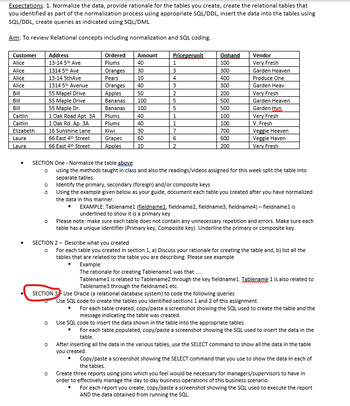
Database System Concepts
7th Edition
ISBN: 9780078022159
Author: Abraham Silberschatz Professor, Henry F. Korth, S. Sudarshan
Publisher: McGraw-Hill Education
expand_more
expand_more
format_list_bulleted
Question
Just the section 3 only

Transcribed Image Text:Expectations: 1. Normalize the data, provide rationale for the tables you create, create the relational tables that
you identified as part of the normalization process using appropriate SQL/DDL, insert the data into the tables using
SQL/DDL, create queries as indicated using SQL/DML
Aim: To review Relational concepts including normalization and SQL coding.
Customer
Alice
Address
13-14 5th Ave
Ordered
Plums
Amount
Priceperunit
Onhand
40
1
100
Vendor
Very Fresh
Alice
1314 5th Ave
Oranges
30
3
300
Garden Heaven
Alice
13-14 5th Ave
Pears
10
4
400
Alice
1314 5th Avenue
Oranges
40
3
300
Produce One
Garden Heav.
Bill
55 Mapel Drive
Apples
50
2
200
Very Fresh
Bill
55 Maple Drive
Bananas
100
5
500
Garden Heaven
Bill
55 Maple Dr.
Bananas
100
5
500
Garden Hyn,
Caitlin
1 Oak Road Apt. 3A
Plums
40
1
100
Very Fresh
Caitlin
1 Oak Rd. Ap. 3A
Plums
40
1
100
V. Fresh
Elizabeth
16 Sunshine Lane
Kiwi
30
7
700
Laura
66 East 4th Street
Grapes
60
6
600
Veggie Heaven
Veggie Haven
Laura
66 East 4th Street
Apples
10
2
200
Very Fresh
•
SECTION One - Normalize the table above
°
°
using the methods taught in class and also the readings/videos assigned for this week split the table into
separate tables.
Identify the primary, secondary (foreign) and/or composite keys
° Using the example given below as your guide, document each table you created after you have normalized
the data in this manner.
°
EXAMPLE: Tablename1 (fieldname1, fieldname2, fieldname3, fieldname4) - fieldname1 is
underlined to show it is a primary key
Please note: make sure each table does not contain any unnecessary repetition and errors. Make sure each
table has a unique identifier (Primary key, Composite key). Underline the primary or composite key.
SECTION 2 - Describe what you created
о
For each table you created in section 1, a) Discuss your rationale for creating the table and, b) list all the
tables that are related to the table you are describing. Please see example
Example:
The rationale for creating Tablenamel was that.....
Tablename1 is related to Tablename2 through the key fieldname1. Tablename 1 is also related to
Tablename3 through the fieldname1 etc.
SECTION 3 - Use Oracle (a relational database system) to code the following queries
о
°
о
Use SQL code to create the tables you identified sections 1 and 2 of this assignment.
For each table created, copy/paste a screenshot showing the SQL used to create the table and the
message indicating the table was created.
Use SQL code to insert the data shown in the table into the appropriate tables.
For each table populated, copy/paste a screenshot showing the SQL used to insert the data in the
table.
After inserting all the data in the various tables, use the SELECT command to show all the data in the table
you created.
Copy/paste a screenshot showing the SELECT command that you use to show the data in each of
the tables.
Create three reports using joins which you feel would be necessary for managers/supervisors to have in
order to effectively manage the day to day business operations of this business scenario.
For each report you create, copy/paste a screenshot showing the SQL used to execute the report
AND the data obtained from running the SQL.
Expert Solution
This question has been solved!
Explore an expertly crafted, step-by-step solution for a thorough understanding of key concepts.
Step by stepSolved in 2 steps

Knowledge Booster
Similar questions
- I'm not sure what the difference is between xrange and range.arrow_forwardIs the following code for a wall mural a valid UPC number? If not, what should the check digit be in order to make this a valid UPC code> 0 88085 10811 4arrow_forwardUse Matlab to Plot the graph shown in image 2 using data in table on image 1, BMI= W*H Where W is the weight in kilograms and H is the height in meters. Or the four color curves, use the line width ‘3’. To display a BMI of a person use the following: circular MarkSize ‘8’, MarkerEdgeColor ‘cyan’. To display this you have to enter two values. these are the Height in meters and Weight in kilograms. And inform the outcome results to the person from the command window.arrow_forward
arrow_back_ios
arrow_forward_ios
Recommended textbooks for you
 Database System ConceptsComputer ScienceISBN:9780078022159Author:Abraham Silberschatz Professor, Henry F. Korth, S. SudarshanPublisher:McGraw-Hill Education
Database System ConceptsComputer ScienceISBN:9780078022159Author:Abraham Silberschatz Professor, Henry F. Korth, S. SudarshanPublisher:McGraw-Hill Education Starting Out with Python (4th Edition)Computer ScienceISBN:9780134444321Author:Tony GaddisPublisher:PEARSON
Starting Out with Python (4th Edition)Computer ScienceISBN:9780134444321Author:Tony GaddisPublisher:PEARSON Digital Fundamentals (11th Edition)Computer ScienceISBN:9780132737968Author:Thomas L. FloydPublisher:PEARSON
Digital Fundamentals (11th Edition)Computer ScienceISBN:9780132737968Author:Thomas L. FloydPublisher:PEARSON C How to Program (8th Edition)Computer ScienceISBN:9780133976892Author:Paul J. Deitel, Harvey DeitelPublisher:PEARSON
C How to Program (8th Edition)Computer ScienceISBN:9780133976892Author:Paul J. Deitel, Harvey DeitelPublisher:PEARSON Database Systems: Design, Implementation, & Manag...Computer ScienceISBN:9781337627900Author:Carlos Coronel, Steven MorrisPublisher:Cengage Learning
Database Systems: Design, Implementation, & Manag...Computer ScienceISBN:9781337627900Author:Carlos Coronel, Steven MorrisPublisher:Cengage Learning Programmable Logic ControllersComputer ScienceISBN:9780073373843Author:Frank D. PetruzellaPublisher:McGraw-Hill Education
Programmable Logic ControllersComputer ScienceISBN:9780073373843Author:Frank D. PetruzellaPublisher:McGraw-Hill Education

Database System Concepts
Computer Science
ISBN:9780078022159
Author:Abraham Silberschatz Professor, Henry F. Korth, S. Sudarshan
Publisher:McGraw-Hill Education

Starting Out with Python (4th Edition)
Computer Science
ISBN:9780134444321
Author:Tony Gaddis
Publisher:PEARSON

Digital Fundamentals (11th Edition)
Computer Science
ISBN:9780132737968
Author:Thomas L. Floyd
Publisher:PEARSON

C How to Program (8th Edition)
Computer Science
ISBN:9780133976892
Author:Paul J. Deitel, Harvey Deitel
Publisher:PEARSON

Database Systems: Design, Implementation, & Manag...
Computer Science
ISBN:9781337627900
Author:Carlos Coronel, Steven Morris
Publisher:Cengage Learning

Programmable Logic Controllers
Computer Science
ISBN:9780073373843
Author:Frank D. Petruzella
Publisher:McGraw-Hill Education